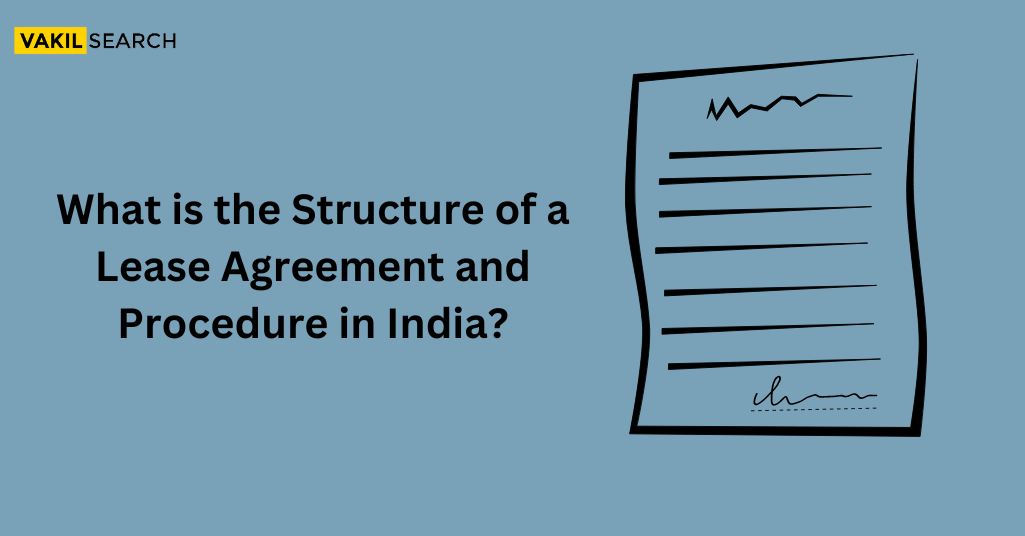This overview looks into the structure of lease agreements in India, outlining legal frameworks and procedural steps. Gain insights into the comprehensive leasing process to understand it effectively.
Introduction
A lease agreement is a legally binding contract that establishes the terms and conditions under which a lessor and lessee may occupy a piece of property. Lease agreements differ from rent agreements in India due to certain unique aspects in the structure of lease agreement. Although they are sometimes confused for one another, leases and rent agreements have distinct meanings; a lease involves a temporary transfer of ownership, whereas a rent agreement gives the landlord complete authority. Navigating the legal complexities involved in property leasing requires an understanding of the subtleties in the format for lease agreements in India.
The format of lease agreements in India consists of particular terms and guidelines that are specified by the lessor and approved by both parties. Protecting the rights of lessor and lessee and establishing the conditions of property occupation without granting ownership, this legal agreement is important. To avoid any potential misuse, the leasing agreement must be carefully drafted using exact language. The lease agreement becomes legally binding if it is notarised and registered, providing protection from arbitrary eviction and excessive rent assessments. A well-written lease agreement, which is essential to property transactions, guarantees accountability, openness, and legal compliance for lessors and lessees in India.
Delhi’s ‘Anywhere Registration’ programme breaks down location barriers across 22 sub-registrar offices. This allows people to choose any office for document registration, reducing queues and addressing demand fluctuations. Around 2,000 documents in 28 categories are registered daily. Residents can now upload documents online and schedule appointments through the new National Generic Document Registration System for added convenience.
Structure for Lease Agreement in India
A lease agreement specifies the agreed-upon terms and conditions basis which the said property has been leased out. These terms and conditions must be followed by both the lessor and the lessee.
- The Lease Document needs to be signed and notarised and has to be on stamp paper.
- Various elements need to be covered in a lease agreement for the protection of the lessor and the lessee.
Other common and important elements that must be included in a Structure for a lease agreement in India are given below:
- The names of both the lessor (the landlord) and the lessee (the tenant) or their agents
- Description of the property, such as location, address, built area, etc.
- The amount of rent that will be charged and the date on which it will need to be paid. This should also include any period of grace that is allowed for late payment, and if there are any penalties, such as late charges, that will need to be paid
- The mode in which the rent needs to be paid
- What will the usage be of the leased property? What are the activities that can be performed on the leased Property Registration?
- Various ways in which the agreement can be terminated before the date of its expiration, along with any charges that will be levied for such termination
- The amount that has been given as a security deposit along with the account in which the security deposit is being held
- List of the utilities that the lessor has provided and, if there is any charge for these utilities levied by the lessor, in what way will the charge for those utilities be determined
- List of the facilities and amenities on the premises that are available for the lessee to make use of or the lessee is entitled to use, such as the security system and swimming pool
- Various rules and regulations, for example, rules related to noise, allowing pets, holding parties, etc. Also, the penalty that will be levied for violating the specified rules
- Specifying where the parking is available, and if there is designated parking, it should be specified with the location
- How requests by the lessee for repair will be handled and what will the procedure be in the case of emergency requests
- The period for which the lease agreement will be in effect
- Whether or not the lessee needs to insure the property. Such a clause is generally built into lease agreements for commercial rental
- The terms will be enforced if the lease is to be extended.
Importance of Lease Agreement In India
In simple terms, a lease agreement is very important because it’s like a rulebook for people who rent or lease a place to live or run a business. It out all the important details, such as how much rent you need to pay, how long you can stay, and what you can or can’t do with the property. It’s like a roadmap that helps both the person renting the place (the tenant) and the person who owns it (the landlord) understand their rights and responsibilities. Without a lease agreement, things can get confusing, and disagreements may arise. So, it’s a kind of agreement that keeps everything clear and fair for everyone involved.
Procedure for Lease Agreement in India
- Draft the lease agreement with consent on all points between the lessor and the lessee. This then needs to be printed on a Stamp paper of the required value
- The lessor and lessee will need then to sign the lease agreement in front of two witnesses
- Those two witnesses need to sign the lease agreement and attest to it
- The lease agreement document then needs to be registered at the nearest Sub-Registrar office once the applicable registration charges are paid. Notarisation can also be done.
Conclusion
With a clear understanding and full agreement between the lessor and the lessee, the lease agreement should be signed, signed, and notarised/registered. This will make life easy for all concerned parties to clearly understand their responsibility and role and that of the other party. Generally, the relationship between a lessor and a lessee is a cordial one, yet it is sensible to have a written agreement to deal with any possible future misunderstandings or discrepancies.
Read More :










